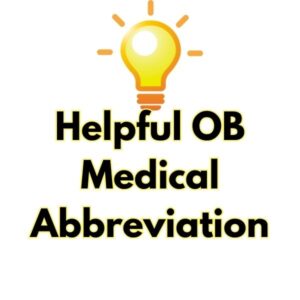Table of Contents
OB Medical Abbreviation
OB – Obstetrician
Gyn – Gynecologist
OB-Gyn – Obstetrics & Gynecology

If you’re wondering what the OB medical abbreviation means, you’ve come to the right place. An obstetrician is a medical specialist who cares for pregnant women and delivers newborns. OBGyn or Obstetrics and gynecology (OBG) is a medical specialty concerned with the female reproductive system, including pregnancy and childbirth.
In this post, we will cover the various varieties of OB medical abbreviations, their clinical applications, and the advantages of utilizing the OB abbreviation.
ObGyn Medical Terminology List
The following are some of the most commonly used OB medical acronyms in clinical practice:
AC — Abdominal circumference
ACH — After coming head
AD — Autosomal Dominant
AFI – Amniotic Fluid Index
AIDS — Acquired Immuno Deficiency Syndrome
AMTSL — Active Management of Third Stage of Labour
ANC — Antenatal clinic
APH — Antepartum hemorrhage
AR – Autosomal Recessive
ARM – Artificial rupture of the membranes
ASD – Atrial Septal Defect
AV — Anteverted (uterus)
BBA — Born before arrival (of the midwife)
BFHI – Baby Friendly Hospital Initiative
BMI — Body mass index
BOH — Bad obstetric history
BPD — Biparietal diameter
BPS – Biophysical Score
BPP — Biophysical Profile
BSO — Bilateral salpingo-oophorectomy
BTB — Breakthrough bleeding
CAVSD – Combined atrial ventricular septal defect
CCAM – Congenital Cystic Adenomatoid Malformation
CCT – Controlled cord traction
CDH – Congenital Diaphragmatic Hernia
CEFM — Continuous Electronic Fetal Monitoring
CF – Cystic Fibrosis
CH – Cystic Hygroma
CIN – Cervical intraepithelial neoplasia
CISC – Clean intermittent self-catheterization
CLC — Community-led care
CM – Cisterna Magna
COCP — Combined oral contraceptive pill
CPD — Cephalo-pelvic disproportion
CRL – Crown-rump length
CS – Caesarean section
CSSM — Child Survival and Safe Motherhood
CT — Combined Test (or CT scan)
CTG – Cardiotocograph
CVS – Chorionic Villous Sample
DA – Duodenal Atresia
DCDA — Dichorionic Diamniotic Twins
DIC – Disseminated intravascular coagulation
DOA — Detrusor overactivity
DOB – Date of birth
DS — Downs syndrome
DUB — Dysfunctional uterine bleeding
DV – Ductus Venosus
DVT – Deep venous thrombosis
EB – Endometrial biopsy
EC – Emergency contraception
ECV – External cephalic version
EDD – Estimated date of delivery
EDF – End diastolic flow (umbilical cord Doppler)
EFW – Estimated fetal weight
ERPC – Evacuation of retained products of conception
ET – Endometrial thickness
EUA – Examination under anesthesia
FBS – Fetal blood sample
FGM – Female genital Mutilation
FH – Fetal heart
FHH – Fetal heart heard
FHS – Fetal heart sound
GDM – Gestational Diabetes Mellitus
GFR – Glomerular Filtration Rate
HELLP – Hemolysis, Elevated Liver Enzymes, Low Platelets
IUGR – Intrauterine Growth Restriction
LGA – Large for Gestational Age
NICU – Neonatal Intensive Care Unit
NST – Non-Stress Test
OCP – Oral Contraceptive Pill
PROM – Premature Rupture of Membranes
PPH – Postpartum Hemorrhage
PROM – Premature Rupture of Membranes
P/V: Per Vaginal
SROM – Spontaneous Rupture of Membranes
TORCH – Toxoplasmosis, Other (syphilis, varicella-zoster virus), Rubella, Cytomegalovirus, and Herpes
VBAC – Vaginal Birth After Cesarean
VTE – Venous Thromboembolism
ZIFT – Zygote Intrafallopian Transfer
What Are Some Frequent Errors About the OB Medical Abbreviation?
Another prevalent misunderstanding regarding the OB medical abbreviation is that it is solely used by doctors and nurses. In truth, recognizing medical abbreviations like OB can benefit patients and their families as well. Patients who understand what their doctor is saying can feel more powerful and involved in their own care. This can result in improved health outcomes and increased patient satisfaction.
How Can Healthcare Professionals Make Certain That Medical Abbreviations Are Used Safely and Effectively?
While medical abbreviations such as OB can be extremely useful, they can also be hazardous if used wrongly. Healthcare professionals should follow a few best practices to ensure that medical abbreviations are used safely and effectively:
- Use only acronyms approved by your organization: Healthcare providers should only use abbreviations recognized by their organization. The use of non-standard abbreviations might cause misunderstanding and errors.
2. Unfamiliar abbreviations should be spelled out and explained to patients: When using an unfamiliar abbreviation with a patient, healthcare providers should spell it out and explain what it means.
3. When in doubt, double-check: If a healthcare provider is unsure about an abbreviation, they should check with a colleague or look it up in a reference book.
4. Add context: When using an abbreviation, healthcare providers should always include context so that people understand what it means.
Conclusion
Finally, the abbreviation OB refers to an obstetrician and is used in patient care, medical documentation, medical billing, and coding. Obstetricians are physicians who focus on pregnancy, delivery, and postpartum care. They are also known as gynecologists, as they treat women during their reproductive years. While medical abbreviations such as OB can be extremely useful, they can also be hazardous if used wrongly. To ensure that medical abbreviations are used safely and efficiently, healthcare providers should follow best practices.